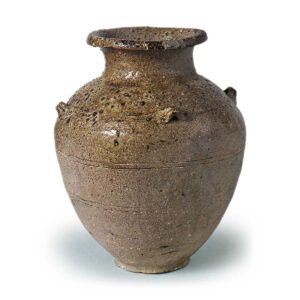
12th century
Height 23.8cm, Bowl diameter 12.2cm, Body diameter 20.1cm, Bottom diameter 8.1cm
Aichi Prefectural Ceramic Museum
This four-lobed jar has a bulging body and is made of a coarse grayish-white clay containing many fine iron particles. The neck of the mouth is constricted in the center and the mouth rim is open, with a triangular cross section at the edge of the mouth rim. The body has three parallel stripes. The provenance of this jar, which could be called a “four-ear, three-stripe jar,” has not yet been determined. However, judging from the glaze tone on the base and shoulders, it is very similar to an early mountain tea bowl from the southern part of the Sanage Kiln near the Chita Peninsula, so it has been placed in the Sanage Kiln category. In terms of period, it is thought to be in the first half of the 12th century. By the way, the three parallel lines on the body are arranged in a similar manner to the three stripes on Tokoname pots, and may be considered to be the prototype of the Tokoname pots. Such three-rowed parallel sunken line design is also seen on the outer vessel of the sutra case shown in Fig. 117, and is based on the same pattern technique. This type of design is often seen in the Chinese porcelain vases from the Pizhou kiln system, and it is thought that the influence of these vases was quickly adopted by the Sanage kiln.
Tokoname three-stripe jars usually have a single sunken line in the upper, middle, and lower parts, which has been interpreted religiously as a manifestation of the yin-yang five elements theory or the five-ring philosophy. The purpose of their use is highly religious, but there is some inconsistency, with some having only two lines and others having five, so they are not divisible by the five-ring philosophy. Rather, it is more reasonable to think that they are copies of the early Sanage kiln tea bowls with the three parallel sunken line patterns.



